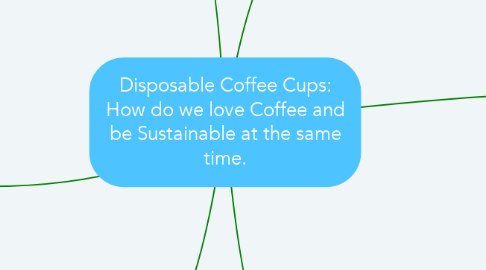Disposable Coffee Cups: How do we love Coffee and be Sustainable at the same time.
by Nathan Pearson

1. How many take away Coffee cups are used each year.
1.1. The average American white collar employee consumes about 500 coffees from disposable cups every year. (Carry your cup, n.d.)
1.2. each year five hundred billion disposable cups are consumed around the world (Readfearn, 2015)
1.3. more than four hundred disposable coffee cups are used each week across the four campus in our school network. (Personal Communication, 2017)
1.4. it's estimated that Australians use one billion disposable coffee cups each year (Whyte, 2016)
2. how do we make a sustainable decision when buying take away coffee
2.1. Bring Your Own Cup programs offer various benefits uptake of these programs is still quite Low with program awareness also very low in instances. (Mauricio, 2014, p. 5)
2.2. Only buying coffee from cafes and shops that advertise 100% Biodegradable coffee cups.
2.3. Countries are such as France are moving to Ban the use of non biodegradable disposable products with the Energy Transition for Green Growth Act (Eastaugh, 2016)
3. Why are they harmful to the environment
3.1. twenty million trees are used each year to make paper cups (BetaCup, n.d.)
3.2. twelve thousand mega liters of water is used each year in the production of disposable coffee cups (BetaCup, n.d.)
4. how are they made
4.1. Polyethylene (PE) is used as a liner for many disposable cups to waterproof and prevent leaking (Marsh & Bugusu, 2007)
4.2. the American Food and Drug Administration regulates the use of recyclable paper in Paper cups stipulated in the Code of Federal Regulations Title 21 section 176.260 (U.S. Food and Drug Administration, 2017)
5. How can they be recycled?
5.1. repurposing your used coffee cups for use around the home and in the office. (Mazzoni, 2012)
5.2. The Polyethylene lining found in most cups makes is non biodegradable and difficult to recycle. (Potter, 2017)
6. are there alternatives to a Polyethylene Lined cup
6.1. Styrofoam cups: Although no longer produce chlorofluorocarbons in the manufacturing process. a vast majority if Cafe's will not use them as they are still perceived to have significant environment impact on the Ozone layer (Ziada, 2009).
6.2. Biodegradable plastic lined cups: These cups although are Biodegradable they do require very specific conditions to do so. these conditions are not available at many recycling facilities and results in many of these cups ending up in land fill where conditions are not suitable for the Biodegradable process (Ziada, 2009).
6.3. Reusable Cups: Resuable cups are perhaps the best alternative to using disposable cups this is because they have a much more sustainable Life cycle Assessment then alternate disposable products. in terms of energy usage and subscuant Co2 emissions a consumer would brake even after using the cup 50 times(Broca, 2008).


